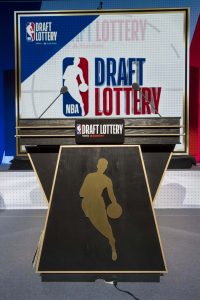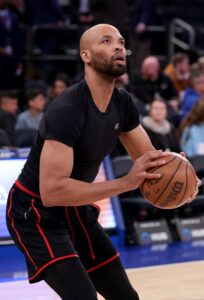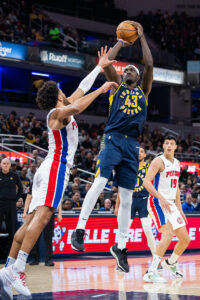We’re still nearly three months away from the 2024 NBA draft, but before we get to June 26, there are several other important dates and deadlines on the calendar. Here are some of those dates and deadlines worth keeping an eye on:
April 27 (11:59 pm ET): Deadline for early entrants to declare for the draft
College players and international early entrants have until the end of the day on April 27 to submit their names into the 2024 NBA draft pool. They can withdraw their names later if they decide they’re not quite ready to go pro, though if college players want to maintain their NCAA eligibility, they can’t hire an agent who’s not certified by the NCAA.
Once the early entrant list is set, NBA teams can begin conducting or attending workouts for those players.
May 11-12: NBA G League Elite Camp
In 2019, the Elite Camp – having recently been revamped by the NBA – consisted of 40 veteran G League invitees participating in the first half of the event, followed by 40 top draft-eligible players (who weren’t invited to the actual combine) taking part in the second half.
After being canceled in 2020 due to the COVID-19 pandemic, the Elite Camp returned in 2021, but only featured 40 draft-eligible prospects, without the G League players. That format carried over to 2022, with 44 prospects in attendance, and to 2023, when 50 prospects were invited. It’s safe to assume the event will focus exclusively on draft-eligible players again this season.
May 12: NBA draft lottery
 The 2024 draft lottery will be the sixth one employing the format that was introduced in 2019. With the lottery odds flattened out, the NBA’s worst team has a 14% shot at the No. 1 overall pick, as opposed to the 25% chance it had prior to ’19.
The 2024 draft lottery will be the sixth one employing the format that was introduced in 2019. With the lottery odds flattened out, the NBA’s worst team has a 14% shot at the No. 1 overall pick, as opposed to the 25% chance it had prior to ’19.
While the new system reduced the odds that the league’s very worst teams would claim the picks at the top of the draft, it has been several years since we saw any real long shots become big winners on lottery night.
One of the NBA’s worst three teams has been awarded the No. 1 spot in each of the last four lotteries, including when the Spurs won the 2023 lottery for the right to draft Victor Wembanyama.
Maybe we’re due for a surprise on lottery this May, though it’s also worth noting that this year’s draft class doesn’t feature a clear-cut top prospect like Wembanyama in 2023. Winning the 2024 lottery would still be a boon, but it won’t necessarily be a franchise-altering moment like it was in San Antonio a year ago.
May 12-19: NBA draft combine
This week-long event, which takes place annually in Chicago, allows NBA teams to get a first-hand look at many of the year’s top draft-eligible players.
The combine is often particularly important for early entrants who have yet to decide whether or not to stay in the draft. The feedback they get at the combine could go a long way toward dictating whether they keep their names in the draft or return to school for another year.
In past years, the draft lottery has taken place after the conclusion of the combine. Interestingly, the two events are flipped this year, which may have an impact on which teams are focusing on which lottery-caliber players in Chicago.
May 29 (11:59 pm ET): NCAA early entrant withdrawal deadline
College underclassmen – and seniors who are eligible to play for more one season – who want to retain their NCAA eligibility will have to withdraw their names from the draft pool by May 29. NBA rules call for a later withdrawal deadline, but the NCAA has its own set of rules that say the deadline is 10 days after the combine ends.
An early entrant could technically wait until after May 29 to withdraw from the draft and could still retain his NBA draft eligibility for a future year. However, he would forfeit his amateur status in that scenario, making him ineligible to return to his NCAA squad. College players who want to play overseas for a year or two before entering the NBA draft could take this route.
June 16 (5:00 pm ET): NBA early entrant withdrawal deadline
This is the NBA’s final deadline for early entrants to withdraw their names from the draft pool and retain their draft eligibility for a future year.
By this point, we generally know whether or not a college player decided to keep his name in the draft, but this is an important deadline for international players, who aren’t subject to the same restrictions as college players. We’ll likely hear about several international early entrants withdrawing from the draft during the days leading up to June 16.
June 26 and 27: NBA draft days
The most exciting few weeks of the NBA offseason unofficially get underway on draft day, which is often when several of the first major trades of the summer are completed and when we get a sense of which direction certain teams are heading.
In 2024, for the first time, “draft day” actually refers to two days: Wednesday, June 26 and Thursday, June 27. The NBA and NBPA have agreed to make the draft a multi-day event, with the first round occurring on Wednesday and the second round taking place on Thursday.
The hope is that the move will benefit teams, who will get to regroup halfway through the draft to reset their boards and will have more time to consider possible trades; the NBA’s broadcast partners, who will be able to devote more attention to second-round picks that are often made when the television broadcast is in the midst of an ad break; and fans, who won’t have to stay up so late into the night to see the end of the second round.
The hours and days after the second round ends will be hugely important for many of this year’s draft-eligible prospects — a ton of players who aren’t selected with one of the 58 picks in the draft will reach agreements shortly thereafter to play for an NBA team’s Summer League squad, to attend training camp with a club, or to sign a two-way contract.
 The 2024 draft lottery will be the sixth one employing the format that was
The 2024 draft lottery will be the sixth one employing the format that was  For example, when
For example, when  No cap hold can exceed the maximum salary for which a player can sign. For example, the cap hold for a Bird player with a salary above the league average is generally 150% of his previous salary, as noted above. But for someone like Pacers forward
No cap hold can exceed the maximum salary for which a player can sign. For example, the cap hold for a Bird player with a salary above the league average is generally 150% of his previous salary, as noted above. But for someone like Pacers forward